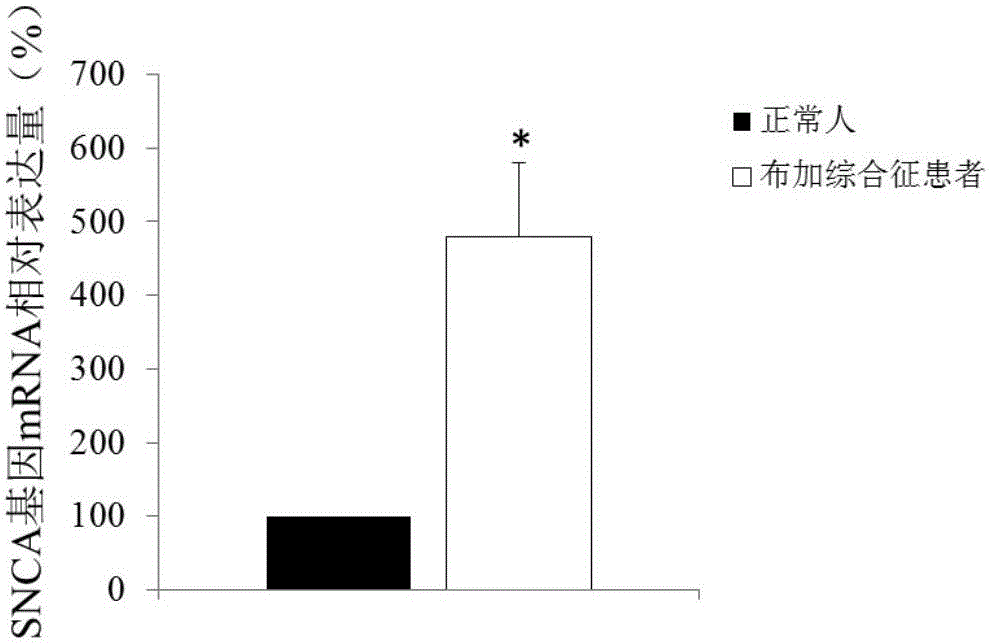Budd-Chiari syndrome diagnosis marker
A syndrome and diagnostic cloth technology, applied in the field of disease diagnosis, can solve the problems of poor natural prognosis, lag in research, lack of effective methods for early diagnosis and treatment, and achieve the effect of providing survival rate
- Summary
- Abstract
- Description
- Claims
- Application Information
AI Technical Summary
Problems solved by technology
Method used
Image
Examples
Embodiment 1
[0038] Example 1 Screening of differentially expressed genes
[0039] 1. Research objects and sample collection
[0040] (1) Research objects: 3 patients with Budd-Chiari syndrome and 5 normal volunteers.
[0041] (2) Sample collection: The subjects were required to fast for at least 12 hours, and at room temperature from 7:00 to 8:00 in the morning of the next day, 10ml of venous blood was drawn into ethylenediaminetetraacetic acid (EDTA) anticoagulant tubes, and 3 times the volume of red blood cells was added for lysis. solution, mix well, place at room temperature for 10 minutes, and centrifuge at 10,000 rpm for 1 minute. Discard the supernatant thoroughly and collect the white blood cell pellet. Add 1ml TRIzol to every 100-200μl blood collected white blood cell pellet, and freeze it at -80℃ for later use.
[0042] 2. Acquisition of total RNA
[0043] Total RNA in blood leukocytes was extracted using TRIzol according to conventional methods.
[0044] 3. RNA concentrati...
Embodiment 2
[0057] Example 2 Large sample verification screened out differentially expressed genes
[0058] The SNCA gene was selected for validation.
[0059] 1. Sample collection
[0060] According to the method in Example 1, 50 peripheral blood samples were collected from Budd-Chiari syndrome patients and 50 normal people.
[0061] 2. Validation at the mRNA level
[0062] 2.1 Extraction of total RNA from blood
[0063] Step is with embodiment 1.
[0064] 2.2 Reverse transcription
[0065] Reverse transcription using Primescript 1 st strand cDNA synthesis kit kit, the operation steps are as follows:
[0066] (1) Add the following reaction liquid in the microcentrifuge tube, as shown in Table 1:
[0067] Table 1 Reaction liquid
[0068] Reagent dose RNA 2.0μg dNTP 1.0μl Oligo(dT) 2.0μl RNase free dH 2 o
Add to 10.0μl
[0069] (2) Incubate at 70°C for 5 minutes, then rapidly cool to 4°C;
[0070] Add the following reagents into a ...
PUM
 Login to View More
Login to View More Abstract
Description
Claims
Application Information
 Login to View More
Login to View More - R&D
- Intellectual Property
- Life Sciences
- Materials
- Tech Scout
- Unparalleled Data Quality
- Higher Quality Content
- 60% Fewer Hallucinations
Browse by: Latest US Patents, China's latest patents, Technical Efficacy Thesaurus, Application Domain, Technology Topic, Popular Technical Reports.
© 2025 PatSnap. All rights reserved.Legal|Privacy policy|Modern Slavery Act Transparency Statement|Sitemap|About US| Contact US: help@patsnap.com

